On Monday, it was the last opportunity to travel during my recent trip to Ukraine. My friends Marla, Jay, Vasyl and I decided for a route eastwards to the towns and villages of Holohory, Zolochiv, Sasiv, Pidhirtsi and Brody with its Jewish heritage sites. Back in Lviv we had a look at Jewish tombstones recently discovered during construction works. Summed up, it was a kaleidoscopic view of beauty and horror.
Holohory is a village south of the road from Lviv to Zolochiv. To visit the Jewish cemetery there was a recommendation by our friend Alex Denysenko. As so often, Alex was right. Holohory Jewish cemetery is situated on a hill next to the village, offering a spectacular view over the surrounding landscape. Albeit, we had trouble to identify the cemetery. Only a few stones and stumps survived and we were for a long time too occupied with the beauty of the place to recognize them in the high grass. Beautiful flowers were all around and the air was filled with the sounds of bees and of a horse neighing somewhere in a distance. The destructions are obviously old and the stones weathered, its inscriptions unreadable. Close to the cemetery is a strange building, known as the ‘Turkish Tower’. Its foundation may root back to the times of invading Ottoman, Tatar or Mongolian horsemen.
On the way to Zolochiv we were contacted by the town’s mayor. He wanted to meet us – in particular Marla. Zolochiv Jewish cemetery is a fenced in empty terrain with a memorial for the murdered Jews. While we were taking pictures and talking a car approached with the mayor, the former mayor, the consultant for international affairs of the municipality and a representative of the local media. Zolochiv’s mayor has not only big plans, he already did something. Together with members of the city council and other volunteers he cleaned the Jewish cemetery just a few weeks ago. “In our town Ukrainians, Poles and Jews shared a common house and I believe this could be the same in the future”, the mayor said during our conversation. An important gesture.
On the way to Sasiv, it was Vasyl who recommended to visit a mass grave site nearby. As in so many other cases it was him who knew so much more about the region than we did. The mass graves and a memorial are hidden in a forest. Jews of Zolochiv and other places were shot there by the Germans. Names are listed on the black granite of the memorial. “In memory of our loved ones”, it reads.
Not much remained of Sasiv’s Jews. Just the fenced in territory of the Jewish cemetery with two ohalim – tombs of prominent rabbis – within. In a distance we saw the bowls of radio telescopes from the Soviet era – a strange view. Not less strange is the view of a giant church next to the road to Brody – in the middle of nowhere. It is part of the complex of Pidhirtsi castle. We found the castle closed – it was a Monday – but we had a look on the magnificent wall paintings in the church.
Until the German invasion, Jews formed the majority of Brody’s population. Centraly located, the ruin of a typical Galician fortress synagogue tells about this time – a stranded ship from a different age. The building is in poor condition, all efforts to save it so far failed. At least, a newly set up sign provides information. Brody had two Jewish cemeteries, an ‘old’ and a ‘new’ one. The old cemetery was destroyed in the Soviets era, the new one is in fairly good condition. All of us had been here before, but Brody Jewish cemetery is always striking, its stones imposing.
After our return to Lviv we headed forward to a construction ground in Barvinok Street. Jewish tombstones had been discovered there just a day before. According to neighbours this is not the first time – whenever there are road repairs, tombstones appear. From a Facebook post by Josef Gelston we learned, the vicinity was a residential area of high German police and SS officers and the streets were paved with Jewish tombstones by prisoners of Yanovska concentration camp. There is a hard to understand sadism in this act of vandalism. And what we see today is what was done to stones – we will never fully understand what was done to people. Meanwhile the stones were brought to the Jewish cemetery by Sasha Nazar and his volunteers of Hesed Arieh, a local Jewish charity organisation.
It was a long day on the roads of Galicia – with so diverse impressions. It will take time to process them. Wrting about it is part of coming to terms with it.

This work is licensed under a Creative Commons Attribution-NonCommercial-NoDerivatives 4.0 International License.
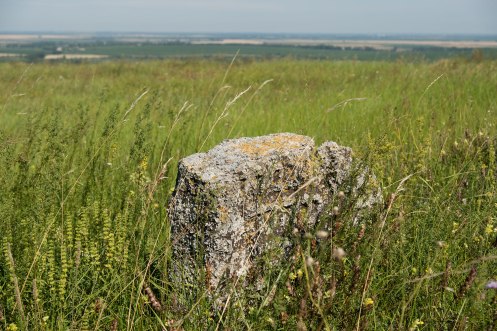


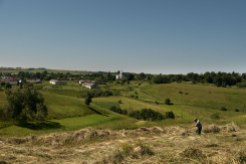
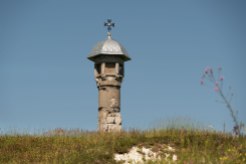
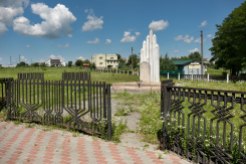

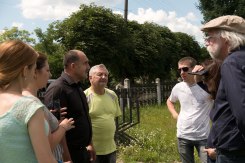


















Remember- not everyone was a Holocaust victim. Some of my family were orphans.They went to family in New York in 1902.
However, wrecking a cemetery is perverse.
Also, I mistakenly thought you went to Podhajce. The synagogue there needed restoration when I saw it in 2001, but had good examples of folk art.This should be a regional attraction because it is a little gem.
To Pidhaitsi (Podhajce) I have been in April, Francine. Have a look here: https://vanishedworld.wordpress.com/2017/04/15/a-long-way-back-to-lviv/
Wow!
Thank you for this— I have been trying to find out more about my family who, as I’ve recently discovered, originate from Goligor (or Holohory). This is the first time I’ve seen pictures of where they’re from and I’d just like to thank you for that.
Is there anything left from the village? I would love to visit one day.
The village is still there – looking quite picturesque, something that came straight out of a Sholem Aleichem story. But as far as I know there are no Jews left.
Christian…amazing photography. I was struck by the one image of the Holohory landscape taken from the cemetery. The picturesque beauty betrays the horrors that must have taken place there.
My dad’s family hails from there. Fortunately the whole family was evicted by the (then) Polish gov’t in March of 1940. TEALMARTZ – if you reach out to me at below email, I can share a little history with you.
Hi Irwin, Thank you so much for offering, I think the email got taken away– would love to know some more history.
I toured with Alex as well. He is amazing. Can I ask you what was your families name that lived in Holohory?
I had no family members in the region.
Hi, I am trying to make my way to holohory as my grandparents had put this location on there documentation before departing to australia.
Just curious did everyone hire a car ? I cant seem to find public transport that way.
Many thanks
Hi Patricia,
public transport exists but is time consuming. You better rent a car or hire a driver with a car.
Good luck!
Christian
Good day Christian, your work is certainly priceless and very much appreciated! My roots are from Podkamien, Sassow and Zloczow. Would you have any other close up photos of the memorial at the mass grave site between Zolochiv and Sasiv (slides 9 & 10)? S. Geller
I don’t think I have close-ups. But the inscription of #10 is well readable if you first click on the image and than by right click open it in a new tab or window.